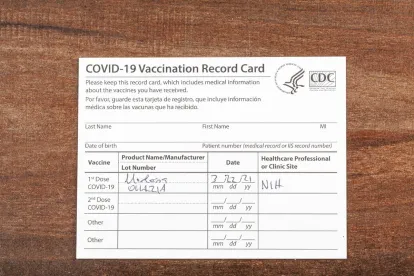This past Friday, September 24, 2021, the White House “Safer Federal Workforce Task Force” issued Guidance construing President Biden’s September 9 Executive Order concerning required COVID-19 vaccination and other safety protocols for certain federal contractors. Consistent with the general approach adopted by the President in the six-pronged “Path out of the Pandemic: COVID-19 Action Plan,” the Task Force has broadly construed the Executive Order, such that the vaccination requirement ultimately will cover an extensive swath of employees.
Key Definitions
Because the Guidance requires vaccination for all “covered contractor employees,” understanding this definition is critical for employers with covered contracts. The Guidance defines “covered contractor employee” to include any “full-time or part-time employee of a covered contractor working on or in connection with a covered contract or working at a covered contractor workplace.” With respect to this definition, critically the Guidance directs that it “includes employees of covered contractors who are not themselves working on or in connection with a covered contract.” Significantly, an employee otherwise falling within this definition is not excluded because the individual works from home or at another remote location.
A “covered contractor workplace” is similarly broadly defined to include any “location controlled by a covered contractor at which any employee of a covered contractor working on or in connection with a covered contract is likely to be present during the period of performance for a covered contract.” Outdoor workplaces are not excluded from this definition.
The extraordinary breadth of the coverage of the Executive Order is further illustrated by the Guidance's direction on what constitutes work performed "in connection with" a covered contract. Specifically, the Guidance directs that "[e]mployees who perform duties necessary to the performance of the covered contract, but who are not directly engaged in performing the specific work called for by the covered contract, such as human resources, billing, and legal review, perform work in connection with [the contract]." This language may present a challenge for employers trying to identify which of their employees are covered by the Guidance.
Additionally, employers cannot limit the reach of the "workplace" concept to a particular portion of a building or a particular area of a campus complex - absent proof by the employer that none of its employees outside the designated area will come into contact with a "covered contractor employee." For almost any workplace, proving the applicability of this exception may be practically unachievable.
Of course, the above definitions all apply in the context of a “covered contract,” which includes (i) a procurement contract for services, construction, or a real property leasehold interest; (ii) a contract for services covered by the Service Contract Act; (iii) a contract for concessions; and (iv) a contract in connection with Federal property or lands and related to offering services for Federal employees, their dependents, or the general public. However, the Executive Order specifically excludes (i) grants, (ii) contracts with Indian tribes, (iii) contracts with a value equal to or less than the simplified acquisition threshold as that term is defined under Federal Acquisition Regulations(“FAR”) (generally $250,000), (iv) employees who work outside the United States, and (v) subcontracts solely for the provision of products.
These requirements apply not only to a "prime contractor," but also to a subcontractor at any tier who is party to a covered contract.
Protocols
-
Vaccination Requirement
While the Executive Order itself was silent on a vaccine mandate, the Guidance instructs that all “covered contractor employees” must be vaccinated, without a testing alternative. The Guidance recognizes that an employer may be required to grant an exemption from the vaccination requirement because of a disability or sincerely held religious belief, practice or observance, but only if the individual is “legally entitled to [that] accommodation.” Accordingly, an employer must appropriately confirm an employee’s alleged medical or religious objection to vaccination.
Importantly, the employer must verify the individual’s vaccinated status by reviewing documentation specified in the Guidance. Also of note, an individual is not excused from the vaccination requirement because he may have some immunity to the virus due to a recent infection, even when supported by a recent antibody test.
-
Masking and Physical Distancing Obligations
While the vaccine requirements addressed in the Guidance are likely to draw the most attention, the Guidance also requires that individuals present in a covered contractor workplace, including contractor employees and visitors, comply with the CDC’s guidance for masking and physical distancing while on site.
The Guidance clearly directs that, in areas of high or substantial community transmission, even fully vaccinated individuals must wear a mask indoors with certain limited exceptions. Additionally, persons who are not fully vaccinated must wear a mask indoors and in certain outdoor settings regardless of the level of community transmission. Moreover, unvaccinated persons, must maintain a distance of at least six (6) feet from others at all times if practicable, including, without limitation, offices, conference rooms and all other communal areas.
CDC recognized exceptions to otherwise recommended mask wearing or physical distancing apply - such as when a person is alone in office with floor to ceiling walls and a closed door.
-
Designation of Coordinator
Covered contractors must designate a person (or persons) to coordinate implementation of and compliance with the Guidance. The designated individual (or individuals) must (i) ensure that information on required COVID-19 workplace safety protocols is provided to covered contractor employees and all other individuals likely to be present at covered contractor workplaces, and (ii) ensure that covered contractor employees comply with the requirements related to the showing or provision of proper vaccination documentation.
What is the Timing for Employers?
The requirements of the Executive Order will be incorporated in all new covered contracts awarded on or after November 14, 2021; however, agencies are encouraged to incorporate those requirements in new contracts entered into between October 15 and November 14.
With respect to contracts originally awarded prior to October 15, the requirements must be incorporated at the point at which an option is exercised, or a renewal or extension is made to that contract. However, the Guidance notes agencies are strongly encouraged under the Guidance to incorporate a clause requiring compliance into existing contracts prior to the date upon which the order requires inclusion of the clause. Significantly the Guidance does not provide any clarification as to whether an agency may seek to impose this contract change unilaterally, such as via the standard “Changes” clauses of the FAR, or whether the approach must be bilateral contract modification.
There is similar encouragement to add the clause to contracts not otherwise covered by the Executive Order, such as those under the relevant dollar threshold or for products rather than services.
Under the Guidance, covered contractor employees must be fully vaccinated no later than December 8, 2021.
After that date, with newly awarded covered contracts, all covered contractor employees must be fully vaccinated by the first day of the period of performance under that newly awarded contract and by the first day of the period of performance on an exercised option or extended renewed contract when the clause is been incorporated into the covered contract. The Guidance does provide some exceptions to address circumstances whereby an agency has an urgent and critical need for a covered contractor to have covered contractor employees begin work on a covered contract or at covered workplace before becoming fully vaccinated.
Practical Takeaways
-
Considering the December 8 vaccination requirement for “covered contractor employees,” federal contractors need to take action to analyze potential coverage and compliance.
-
A starting point, if not already done, is to create a list of all existing federal contracts or subcontracts, as well soon-to-be contracts, and identify key information for each contract such as (i) whether the federal contract falls within the purview of the Executive Order, (ii) what may be an upcoming date of renewal or extension for that contract, and (iii) who would be a “covered contractor employee” and which employer locations would be a “covered contractor workplace” under that contract.
-
Employers who believe they will have covered federal contracts should promptly focus on the logistics of putting these new requirements in place, including how the employer (i) is going to collect proof of vaccination, (ii) process requests for medical and religious exemptions, and (iii) who will serve as the coordinator or coordinators for the program.
As a practical matter, given the very broad scope of employees covered by the vaccination requirement under the Guidance, federal contractors may wish to consider whether to adopt a workforce-wide mandate to avoid the difficulties of identifying which employees are covered, or not covered, by the vaccination requirement.





 />i
/>i

